by Joel Tolman, Director of Impact & Engagement
If you’ve visited Common Ground this fall, you may have noticed the hand-painted crosswalk at the mouth of Common Ground’s driveway, leading into the woods across Springside Avenue from our new building. If you’re curious to learn more, you are welcome to use this new trailhead to explore the Urban Oasis coming to life next door to our campus — and keep reading to learn how Common Ground students, staff, and community partners are working together to reclaim Wintergreen Brook!
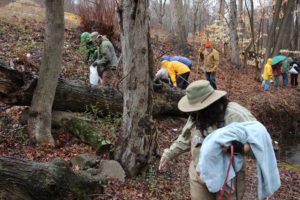
Kathiana Torres helps lead a walk and cleanup along Wintergreen Brook, co-sponsored by the West River Watershed Coalition and the New Haven Bioregional Group.
On a cold and rainy Saturday last Spring, Dave Edgeworth and Kathiana Torres — then a Common Ground science teacher and senior, respectively — led a brave crew of hikers across Springside Avenue from Common Ground’s parking lot. Fortified with hot chocolate, a dozen community members — including members of the West River Watershed Coalition and the New Haven Bioregional Group, Common Ground students and staff, and neighbors in West Rock — followed Kathiana and Dave over the guardrail and into a thicket of early spring poison ivy and brambles.
Their goal: to plot the route of a new walking trail and urban greenspace along Wintergreen Brook, a slow and threatened tributary of the West River. “This project started from a vision of making a safe space for people in our community to interact with nature,” Kathiana explained. “We also started this project so that students can access this space to take water samples or look at birds. This also applies to the camps at Common Ground. They can come in and pick berries and see all the wildlife at Wintergreen Brook.”

West River Stewards Dave Edgeworth, Anthony Duff, and Kathiana Torres work with Chris Ozyck and Erik Ndayishimiye from the New Haven Urban Resources Initiative to plan the first phase of a new urban refuge along Wintergreen Brook.
What Kathiana and her fellow hikers found gave them pause, and also hope. Their garbage bags were soon filled with broken bottles, fast food containers, and abandoned plastic toys; they had to leave the tires and occasional shopping cart for another day. Along with poison ivy — a native plant and good browsing for deer, if dangerous for many people — Japanese Barberry, Multifloral Rose, Mugwort, and a half-dozen other invasive plant species dominated the banks of Wintergreen Brook. Other challenges were not visible, but just as critical; according to Connecticut DEEP and the EPA, Wintergreen Brook has elevated levels of E. coli and fecal coliform, qualifying it as impaired waterway. Still, the community members exploring Wintergreen last spring also found plenty of possibility: oaks and witch hazel that birds love, a beautiful winding stream, the potential path of a continuous walking route from Common Ground to the community garden and horseshoe pits a half mile down the brook.
The public hike last Spring was just one of a number of steps Kathiana, Dave, and other members of Common Ground’s West River Stewards crew have taken to reclaim Wintergreen Brook. With support from an EPA Environmental Justice grant, this crew from Common Ground’s Green Jobs Corps has been steadily identifying and tackling the threats facing the brook since Fall 2015. They started the daunting task of removing the illegally dumped garbage that has accumulated along the stream — and have begun to brainstorm lasting solutions, from cameras to banners showing pictures of neighborhood residents and Common Ground students who value the brook. They explored land ownership — discovering a patchwork of state, federal, city, and privately owned land — and reached out to to Congregation B’nai Jacob in Woodbridge, who generously granted access to the land adjacent to their cemetery and Common Ground’s campus. Rabbi Rona Shapiro saw the project as a chance to join with neighbors to strengthen the neighborhood. “I am delighted to be partnering with Common Ground on this important project.”
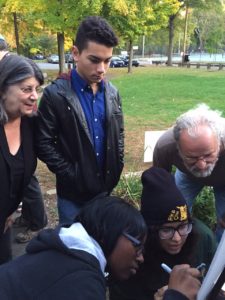
West River Stewards Gabe Rivera, Jalyn Johnson, and Kathiana Torres join members of the West River Watershed Coalition in signing a new management plan for the watershed. The stewards’ work along Wintergreen Brook contributes to larger efforts to reclaim New Haven’s urban waters and create a new scenic greenway in the West River Watershed.
Kathiana and her fellow West River Stewards recognized that their effort was part of something bigger, as well. Their work to create a trail along Wintergreen Brook forms one important leg of the new West River Watershed Scenic Greenway, designated this year by Connecticut’s Department of Energy and Environmental Protection. Their work along Wintergreen Brook also connects to city-wide habitat restoration efforts — aiming to create one of the country’s first urban wildlife refuges. The stewards reached out to Audubon Connecticut, the Urban Resources Initiative, and the U.S. Fish & Wildlife Service, who designated Wintergreen Brook part of a growing network of Urban Oases across New Haven. With help from Yale FES graduate student Erik Ndayishimiye, they created a plan for their first stage of work.
This summer, they started bringing their plans for an urban oasis to life. When Dave Edgeworth retired from Common Ground, environmental science teacher Sharon Brostrom stepped forward to lead the West River Stewards. Sharon and Kathiana rallied a crew of current students and recent graduates — Edwin Calle-Calderon, Khaled Nached, Yasdira Perez, and Josh Barrett — who spent two mornings a week wrestling back poison ivy and Japanese knotweed, hauling out a couple hundred pounds of garbage, and building trails. Another crew of Common Ground students, charged with supporting the growth of urban oases across the city, joined them one day a week. Thanks to the support of URI, Audubon and the Urban Refuge Partnership, the crews were able to restore native bird habitat along the trail, as well: planting mountain laurels, witch hazel, and yucca for year-round shelter, and a wide range of berry-bearing plants — vibernums, serviceberries, blueberries, and witch hazel — to ensure that birds have a steady diet of food.

Science Teacher Sharon Brostrom leads members of the summer West River Stewards Crew — Kathiana, Yasdira, and Edwin — in stewarding new native plantings.
By summer’s end, the West River Stewards had created a horseshoe-shaped trail that reaches Wintergreen Brook at two points, and cleared out all the invasives between the trail and the brook. Of course, the work is far from done. This fall, the crew will take on the stewardship work necessary to sustain the progress they made: watering the new plants, holding back the tide of poison ivy and mugwort from overtaking the oasis, continuing to put a dent in the garbage. They have larger plans, as well. Jalyn Johnson, one long-time member of the Stewards, has begun to dig deeper into the water quality challenges facing the brook, and will present her research at a conference organized by University of Connecticut this fall. The stewards have plans in the works to add steps to steeper sections of the trail, and to extend it further along the brook — continuing progress toward the vision of a watershed-wide greeenway.
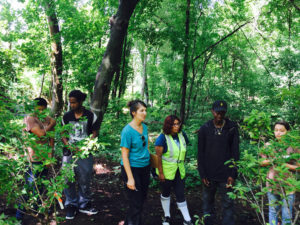
Common Ground students and alumni charged with supporting the development of urban oases across the City of New Haven give Katie Blake of Audubon Connecticut a tour of the Wintergreen Brook Oasis. The crew includes Eric Lopez, Eugenio Garcia, Kathiana Torres, Malik Joyner, and Yaritza Santiago.
And, hopefully, the West River Stewards are beginning to build a different kind of relationship between Wintergreen Brook and the people who pass by on Springside Avenue daily. “Seeing as people are dumping on Springside Avenue, it shows how they have no respect for nature or they don’t feel connected to nature,” explains Kathiana. “I wanted to fix that link between our community and nature. By creating this project we can see the interest of the people in our community. People pass by and ask, ‘what are you doing’ and I explain to them how I want to create a safe space where people can come in and interact with nature without feeling trapped or unsafe. Seeing the progress that has been done on this project really shows that anything is possible if you set your mind to it.”

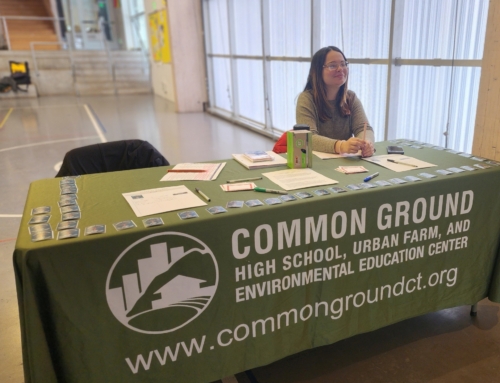
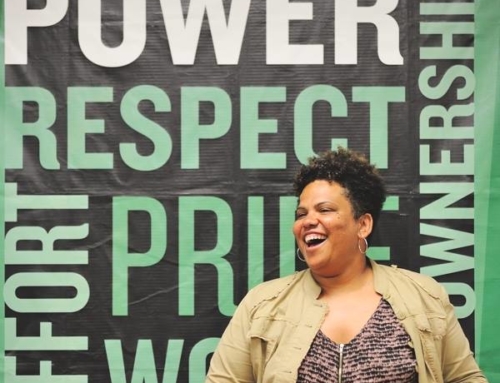
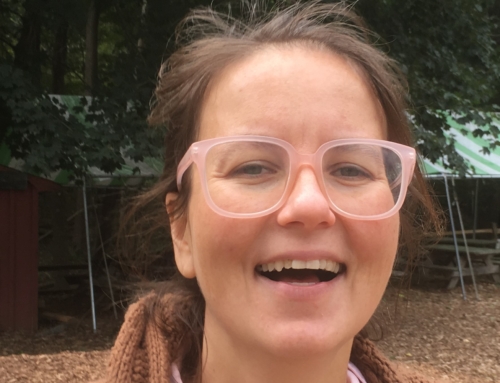
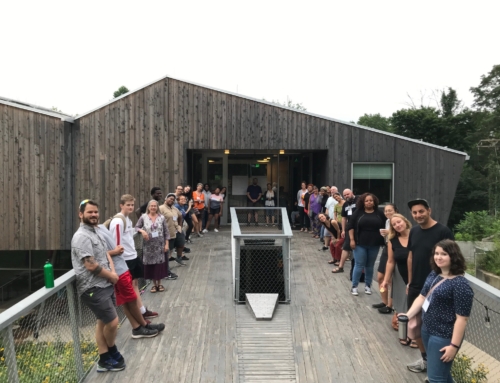
Leave A Comment